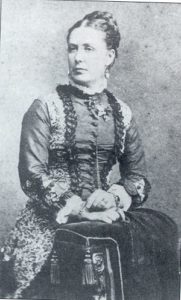A Remarkable Woman
Matilda Dixie’s teaching career began with much excitement in tent schools on the gold fields! A strong gale in September 1854 had blown ‘the rotten tent away’! A 13 year old, she taught at Warrenheip Gully National School, where the school was described as a ‘rotten canvas tent pitched near the mines and mullock heaps of the Ballarat Diggings’. It was 28 x 15 feet (around 9 metres by 5 metres). The school inspector reported there was ‘abundant ventilation’. There were no privvies (toilets); a hole in the ground was used, but it was fully exposed to the view of passers by. From the position of work mistress, she undertook a five-month teacher training course in Melbourne, returning to Ballarat to teach at the Red Hill School (now reconstructed at Sovereign Hill). When Inspector Venables visited Red Hill school in 1858 he found ‘appalling conditions’ with Matilda teaching in ankle deep mud.
Matilda Dixie nee Broadbent had emigrated from Yorkshire, England, in 1854 with her family, and, at the height of the gold rush, they first tried gold mining in Bendigo and then Ballarat. Matilda attracted the attention of Joseph Dixie, twice her age, whom she married in 1859. Owing to Joseph’s poor health they sold all their belongings and left for South Australia. Three months after the birth of their son in July 1860 Joseph Dixie died leaving her with no income. With James Oddie’s help she returned to Ballarat and was appointed teacher at the Ballarat Benevolent Asylum Common School where she remained until 1868. At that time the school at the Benevolent Asylum catered for between 33 and 70 pupils many of whom were orphans. Inspector Sircom visiting the Asylum school in 1863 found her ‘not deficient in energy or ability’ but, he thought, she needed a little more firmness in her teaching. It was while she was here that she became active on the founding committee of the female refuge. This was an institution established in Ballarat by 26 matrons for single pregnant women in 1867. When the Benevolent Asylum School closed in 1868, because the children there were sent to the Ballarat Orphanage or Ballarat Industrial School, Matilda once again found herself out of work.
She then took up a position as principal of Alexandra College, Hamilton. Much emphasis was put on the education of boys in the mid 1800s, however, Matilda strived to make the same education available to girls. She thought that they should be taught more than merely needlework and music. In 1874, only three years after the matriculation (equivalent to Year 12) examination was opened to girls, Matilda Dixie, an excellent teacher, presented some successful female candidates from Alexandra College in Hamilton. Due to professional complications between Hamilton and the Presbyterian Ladies’ College in Melbourne, she again found herself with no position. She had strong views on education for women. She left the Hamilton college in 1876, the year of her father’s and sister’s deaths, and returned once more to Ballarat.
Councillor Shoppee, the owner of a substantial brick building at 98 Dana Street, was aware of her teaching ability, so he encouraged her to establish a school in Ballarat, renting out this building to her and sending along 13 little Shoppee’s for her tuition. She thus established an elementary and secondary school. Queen’s College (now part of Ballarat & Queen’s Anglican Grammar School) in Ballarat was founded around 1877 by this remarkable woman. The first group of 30 girls reportedly began their tuition at the premises in Dana Street in January 1877, which she named “Queen’s College”. (For many years the girl’s school, Queen’s College, was at 1200 Mair Street, the premises now occupied by Australian Catholic University.) She enlisted the services of lecturers like Joseph Flude from the Ballarat School of Mines and, as well as subjects like literature and music, her pupils learnt chemistry and mathematics, an innovative and courageous move in a girls’ school on the goldfields of Ballarat.
The curriculum established at Queen’s Grammar by Matilda Dixie comprised English Grammar, Spelling and Composition, Latin, French, Geography, History, Arithmetic, Euclid, Algebra, Needlework, Scripture, Singing, Drawing, Music, Daily Exercise and Chemistry.
Matilda, during one speech night, reflecting on her own misfortunes called upon her students to ‘use their faith in relation to their experiences in the public examination. In the case of failure’, she urged them ‘to bear defeat with Christian cheerfulness and resignation’.
Matilda’s second marriage, to Frank Goldstraw, a master at Wesley College, took place during 1878 and her subsequent children, Winifred and Amy Rose were born in 1880 and 1882 respectively. An enterprising couple, Frank and Matilda wrote and produced plays with characters such as Lord Fitzboomerang. Matilda also published a novel Milliara: An Australian Romance. By 1896 the Goldstraws had remodelled their home in Melbourne and established Toorak Grammar School. Matilda, a truly resourceful, capable, intelligent women, outlived her second husband by two years, dying at the age of 69 years at Caulfield.
